A Comparative Analysis of EMDR and CBT for Complex Trauma Treatment
VerifiedAdded on 2022/09/29
|10
|2957
|24
Essay
AI Summary
This essay provides a comparative analysis of two primary treatment approaches for complex trauma: Eye Movement Desensitization and Reprocessing (EMDR) and Cognitive Behavioral Therapy (CBT). The introduction establishes the prevalence and impact of complex trauma, highlighting common symptoms and risk factors. The essay then offers an overview of the two therapeutic approaches, detailing their core principles and methodologies. A significant portion of the essay is dedicated to a detailed comparison, contrasting the stages, techniques, and theoretical underpinnings of EMDR and CBT. It highlights the differences in their approaches, such as the length of the treatment process and their views on distressing thoughts. The analysis also discusses the similarities between the two models, including their systematic approach and the use of talk therapy. The essay further examines the effectiveness of each therapy, citing relevant research and studies. The conclusion summarizes the key findings, emphasizing the effectiveness of both EMDR and CBT in managing complex trauma while acknowledging their unique strengths and limitations, and their applicability in treating a wide variety of psychological disorders.

Running head: COMPLEX TRAUMA 1
Complex trauma
Student’s name
Institutional affiliation
Due date
Complex trauma
Student’s name
Institutional affiliation
Due date
Paraphrase This Document
Need a fresh take? Get an instant paraphrase of this document with our AI Paraphraser
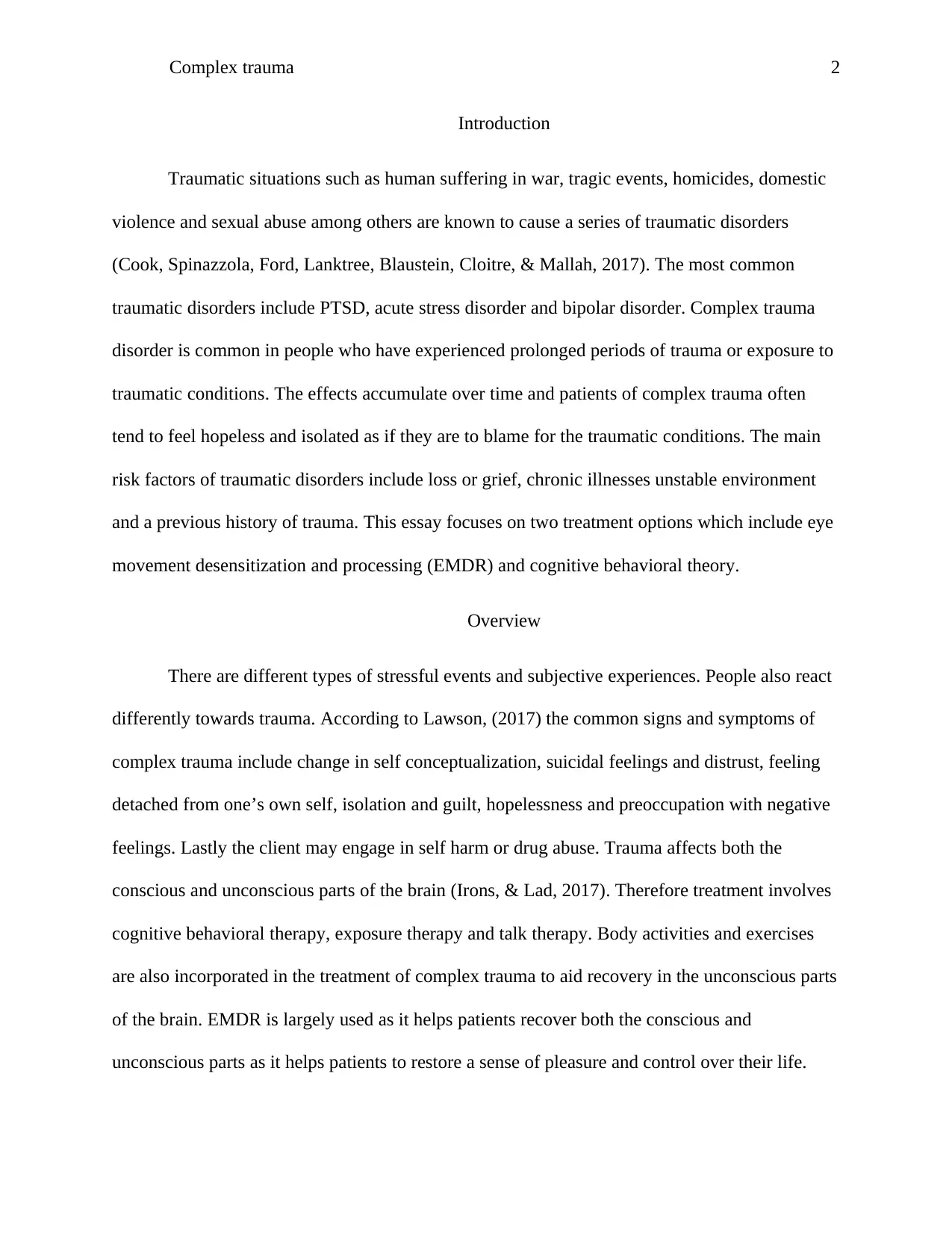
Complex trauma 2
Introduction
Traumatic situations such as human suffering in war, tragic events, homicides, domestic
violence and sexual abuse among others are known to cause a series of traumatic disorders
(Cook, Spinazzola, Ford, Lanktree, Blaustein, Cloitre, & Mallah, 2017). The most common
traumatic disorders include PTSD, acute stress disorder and bipolar disorder. Complex trauma
disorder is common in people who have experienced prolonged periods of trauma or exposure to
traumatic conditions. The effects accumulate over time and patients of complex trauma often
tend to feel hopeless and isolated as if they are to blame for the traumatic conditions. The main
risk factors of traumatic disorders include loss or grief, chronic illnesses unstable environment
and a previous history of trauma. This essay focuses on two treatment options which include eye
movement desensitization and processing (EMDR) and cognitive behavioral theory.
Overview
There are different types of stressful events and subjective experiences. People also react
differently towards trauma. According to Lawson, (2017) the common signs and symptoms of
complex trauma include change in self conceptualization, suicidal feelings and distrust, feeling
detached from one’s own self, isolation and guilt, hopelessness and preoccupation with negative
feelings. Lastly the client may engage in self harm or drug abuse. Trauma affects both the
conscious and unconscious parts of the brain (Irons, & Lad, 2017). Therefore treatment involves
cognitive behavioral therapy, exposure therapy and talk therapy. Body activities and exercises
are also incorporated in the treatment of complex trauma to aid recovery in the unconscious parts
of the brain. EMDR is largely used as it helps patients recover both the conscious and
unconscious parts as it helps patients to restore a sense of pleasure and control over their life.
Introduction
Traumatic situations such as human suffering in war, tragic events, homicides, domestic
violence and sexual abuse among others are known to cause a series of traumatic disorders
(Cook, Spinazzola, Ford, Lanktree, Blaustein, Cloitre, & Mallah, 2017). The most common
traumatic disorders include PTSD, acute stress disorder and bipolar disorder. Complex trauma
disorder is common in people who have experienced prolonged periods of trauma or exposure to
traumatic conditions. The effects accumulate over time and patients of complex trauma often
tend to feel hopeless and isolated as if they are to blame for the traumatic conditions. The main
risk factors of traumatic disorders include loss or grief, chronic illnesses unstable environment
and a previous history of trauma. This essay focuses on two treatment options which include eye
movement desensitization and processing (EMDR) and cognitive behavioral theory.
Overview
There are different types of stressful events and subjective experiences. People also react
differently towards trauma. According to Lawson, (2017) the common signs and symptoms of
complex trauma include change in self conceptualization, suicidal feelings and distrust, feeling
detached from one’s own self, isolation and guilt, hopelessness and preoccupation with negative
feelings. Lastly the client may engage in self harm or drug abuse. Trauma affects both the
conscious and unconscious parts of the brain (Irons, & Lad, 2017). Therefore treatment involves
cognitive behavioral therapy, exposure therapy and talk therapy. Body activities and exercises
are also incorporated in the treatment of complex trauma to aid recovery in the unconscious parts
of the brain. EMDR is largely used as it helps patients recover both the conscious and
unconscious parts as it helps patients to restore a sense of pleasure and control over their life.
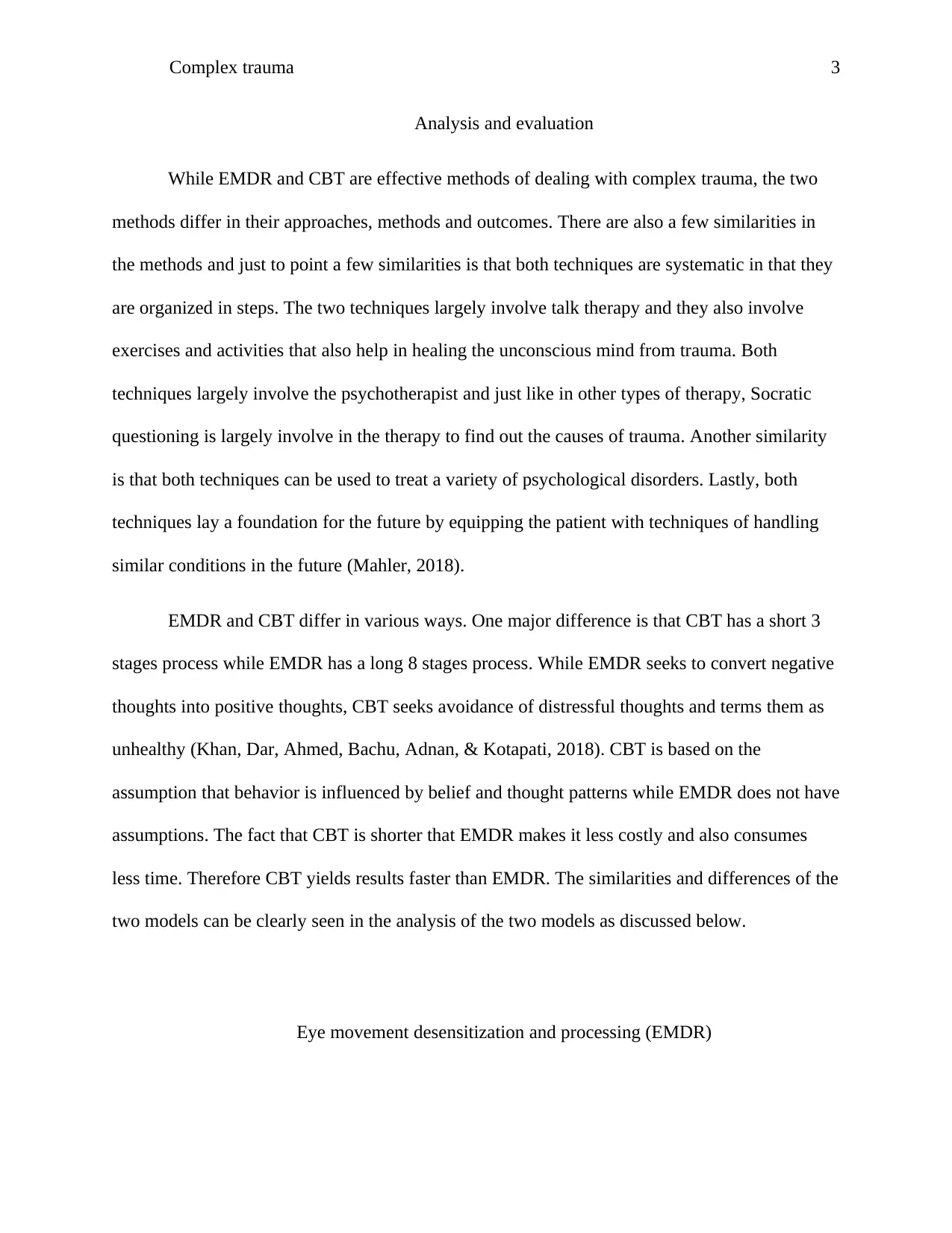
Complex trauma 3
Analysis and evaluation
While EMDR and CBT are effective methods of dealing with complex trauma, the two
methods differ in their approaches, methods and outcomes. There are also a few similarities in
the methods and just to point a few similarities is that both techniques are systematic in that they
are organized in steps. The two techniques largely involve talk therapy and they also involve
exercises and activities that also help in healing the unconscious mind from trauma. Both
techniques largely involve the psychotherapist and just like in other types of therapy, Socratic
questioning is largely involve in the therapy to find out the causes of trauma. Another similarity
is that both techniques can be used to treat a variety of psychological disorders. Lastly, both
techniques lay a foundation for the future by equipping the patient with techniques of handling
similar conditions in the future (Mahler, 2018).
EMDR and CBT differ in various ways. One major difference is that CBT has a short 3
stages process while EMDR has a long 8 stages process. While EMDR seeks to convert negative
thoughts into positive thoughts, CBT seeks avoidance of distressful thoughts and terms them as
unhealthy (Khan, Dar, Ahmed, Bachu, Adnan, & Kotapati, 2018). CBT is based on the
assumption that behavior is influenced by belief and thought patterns while EMDR does not have
assumptions. The fact that CBT is shorter that EMDR makes it less costly and also consumes
less time. Therefore CBT yields results faster than EMDR. The similarities and differences of the
two models can be clearly seen in the analysis of the two models as discussed below.
Eye movement desensitization and processing (EMDR)
Analysis and evaluation
While EMDR and CBT are effective methods of dealing with complex trauma, the two
methods differ in their approaches, methods and outcomes. There are also a few similarities in
the methods and just to point a few similarities is that both techniques are systematic in that they
are organized in steps. The two techniques largely involve talk therapy and they also involve
exercises and activities that also help in healing the unconscious mind from trauma. Both
techniques largely involve the psychotherapist and just like in other types of therapy, Socratic
questioning is largely involve in the therapy to find out the causes of trauma. Another similarity
is that both techniques can be used to treat a variety of psychological disorders. Lastly, both
techniques lay a foundation for the future by equipping the patient with techniques of handling
similar conditions in the future (Mahler, 2018).
EMDR and CBT differ in various ways. One major difference is that CBT has a short 3
stages process while EMDR has a long 8 stages process. While EMDR seeks to convert negative
thoughts into positive thoughts, CBT seeks avoidance of distressful thoughts and terms them as
unhealthy (Khan, Dar, Ahmed, Bachu, Adnan, & Kotapati, 2018). CBT is based on the
assumption that behavior is influenced by belief and thought patterns while EMDR does not have
assumptions. The fact that CBT is shorter that EMDR makes it less costly and also consumes
less time. Therefore CBT yields results faster than EMDR. The similarities and differences of the
two models can be clearly seen in the analysis of the two models as discussed below.
Eye movement desensitization and processing (EMDR)
⊘ This is a preview!⊘
Do you want full access?
Subscribe today to unlock all pages.

Trusted by 1+ million students worldwide
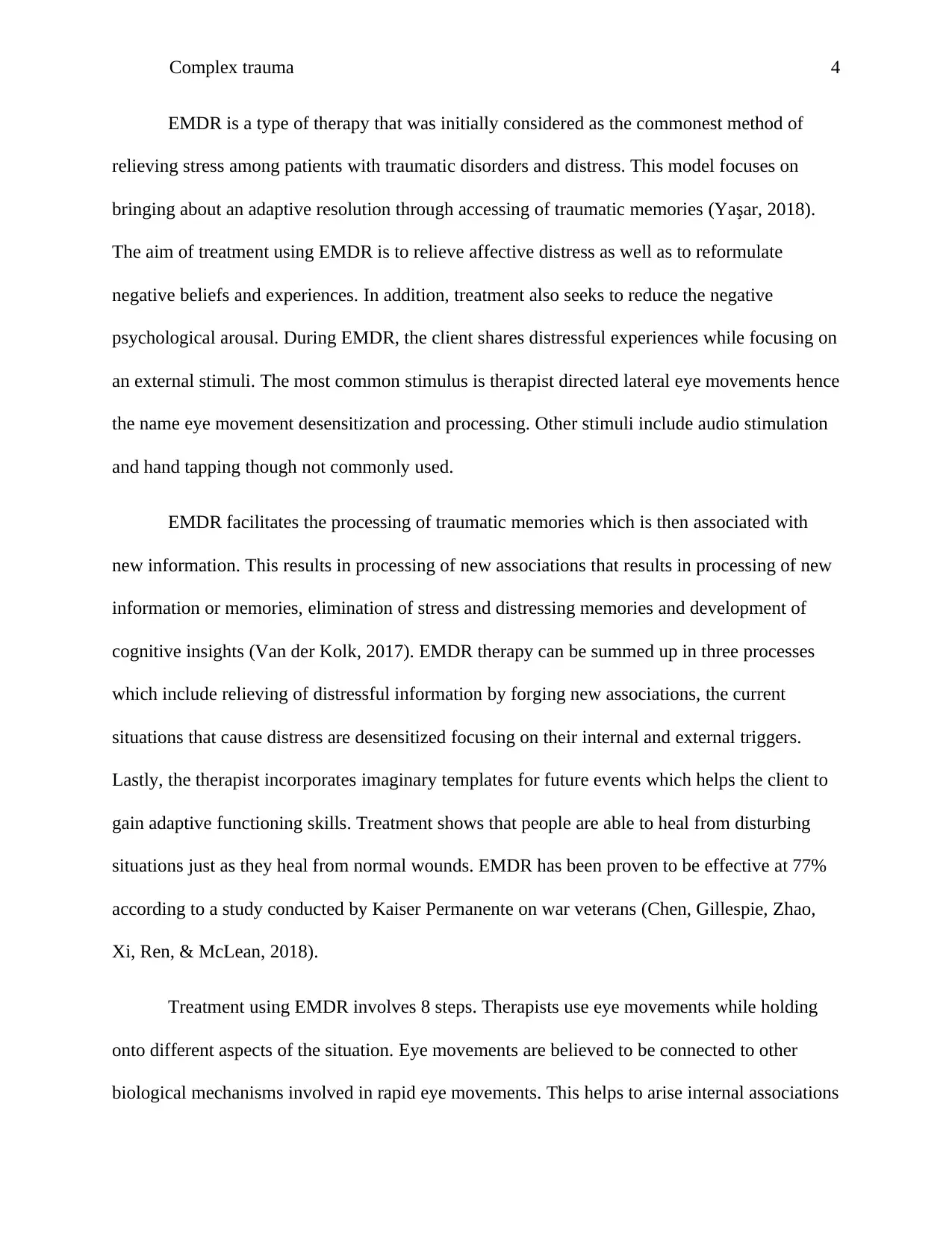
Complex trauma 4
EMDR is a type of therapy that was initially considered as the commonest method of
relieving stress among patients with traumatic disorders and distress. This model focuses on
bringing about an adaptive resolution through accessing of traumatic memories (Yaşar, 2018).
The aim of treatment using EMDR is to relieve affective distress as well as to reformulate
negative beliefs and experiences. In addition, treatment also seeks to reduce the negative
psychological arousal. During EMDR, the client shares distressful experiences while focusing on
an external stimuli. The most common stimulus is therapist directed lateral eye movements hence
the name eye movement desensitization and processing. Other stimuli include audio stimulation
and hand tapping though not commonly used.
EMDR facilitates the processing of traumatic memories which is then associated with
new information. This results in processing of new associations that results in processing of new
information or memories, elimination of stress and distressing memories and development of
cognitive insights (Van der Kolk, 2017). EMDR therapy can be summed up in three processes
which include relieving of distressful information by forging new associations, the current
situations that cause distress are desensitized focusing on their internal and external triggers.
Lastly, the therapist incorporates imaginary templates for future events which helps the client to
gain adaptive functioning skills. Treatment shows that people are able to heal from disturbing
situations just as they heal from normal wounds. EMDR has been proven to be effective at 77%
according to a study conducted by Kaiser Permanente on war veterans (Chen, Gillespie, Zhao,
Xi, Ren, & McLean, 2018).
Treatment using EMDR involves 8 steps. Therapists use eye movements while holding
onto different aspects of the situation. Eye movements are believed to be connected to other
biological mechanisms involved in rapid eye movements. This helps to arise internal associations
EMDR is a type of therapy that was initially considered as the commonest method of
relieving stress among patients with traumatic disorders and distress. This model focuses on
bringing about an adaptive resolution through accessing of traumatic memories (Yaşar, 2018).
The aim of treatment using EMDR is to relieve affective distress as well as to reformulate
negative beliefs and experiences. In addition, treatment also seeks to reduce the negative
psychological arousal. During EMDR, the client shares distressful experiences while focusing on
an external stimuli. The most common stimulus is therapist directed lateral eye movements hence
the name eye movement desensitization and processing. Other stimuli include audio stimulation
and hand tapping though not commonly used.
EMDR facilitates the processing of traumatic memories which is then associated with
new information. This results in processing of new associations that results in processing of new
information or memories, elimination of stress and distressing memories and development of
cognitive insights (Van der Kolk, 2017). EMDR therapy can be summed up in three processes
which include relieving of distressful information by forging new associations, the current
situations that cause distress are desensitized focusing on their internal and external triggers.
Lastly, the therapist incorporates imaginary templates for future events which helps the client to
gain adaptive functioning skills. Treatment shows that people are able to heal from disturbing
situations just as they heal from normal wounds. EMDR has been proven to be effective at 77%
according to a study conducted by Kaiser Permanente on war veterans (Chen, Gillespie, Zhao,
Xi, Ren, & McLean, 2018).
Treatment using EMDR involves 8 steps. Therapists use eye movements while holding
onto different aspects of the situation. Eye movements are believed to be connected to other
biological mechanisms involved in rapid eye movements. This helps to arise internal associations
Paraphrase This Document
Need a fresh take? Get an instant paraphrase of this document with our AI Paraphraser
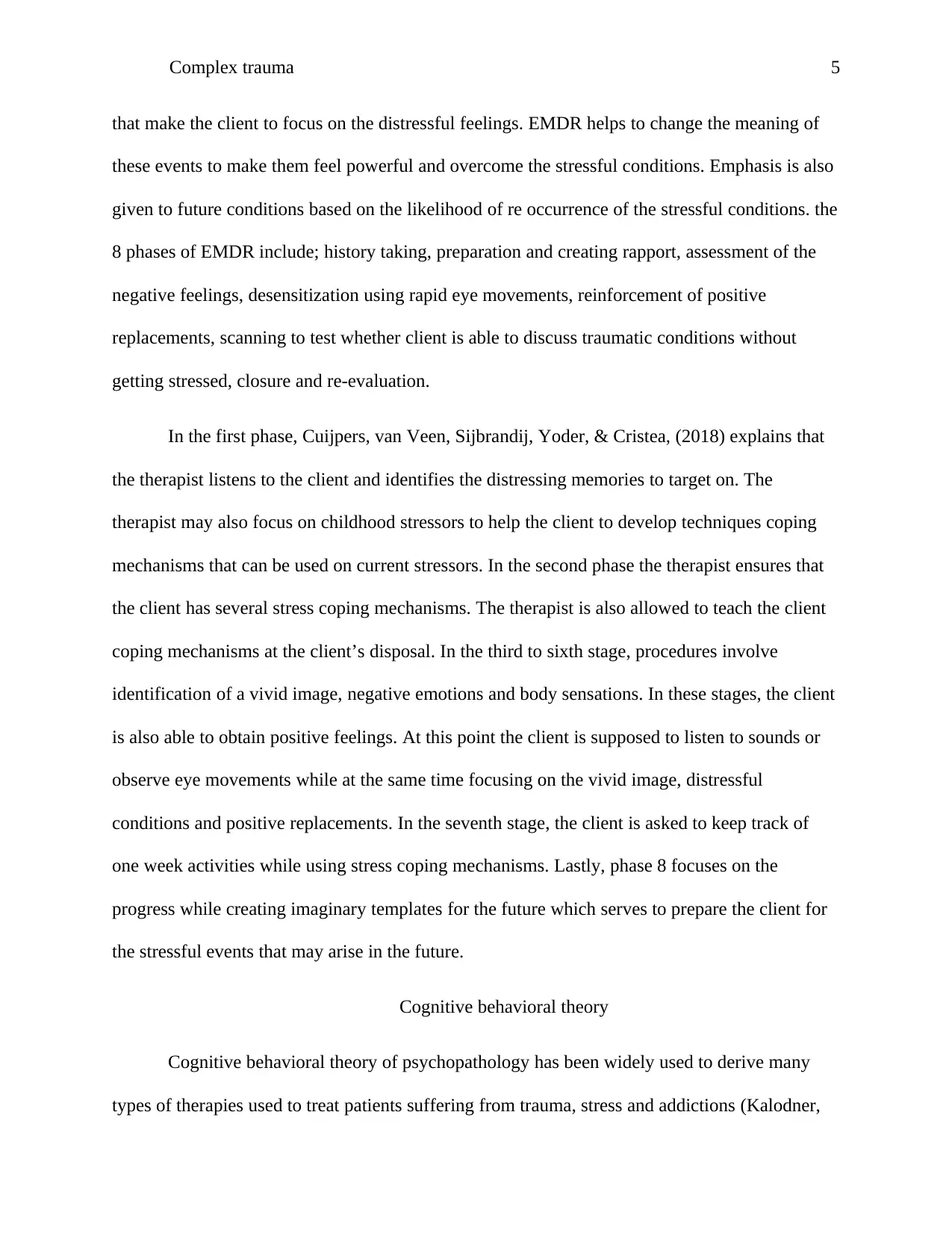
Complex trauma 5
that make the client to focus on the distressful feelings. EMDR helps to change the meaning of
these events to make them feel powerful and overcome the stressful conditions. Emphasis is also
given to future conditions based on the likelihood of re occurrence of the stressful conditions. the
8 phases of EMDR include; history taking, preparation and creating rapport, assessment of the
negative feelings, desensitization using rapid eye movements, reinforcement of positive
replacements, scanning to test whether client is able to discuss traumatic conditions without
getting stressed, closure and re-evaluation.
In the first phase, Cuijpers, van Veen, Sijbrandij, Yoder, & Cristea, (2018) explains that
the therapist listens to the client and identifies the distressing memories to target on. The
therapist may also focus on childhood stressors to help the client to develop techniques coping
mechanisms that can be used on current stressors. In the second phase the therapist ensures that
the client has several stress coping mechanisms. The therapist is also allowed to teach the client
coping mechanisms at the client’s disposal. In the third to sixth stage, procedures involve
identification of a vivid image, negative emotions and body sensations. In these stages, the client
is also able to obtain positive feelings. At this point the client is supposed to listen to sounds or
observe eye movements while at the same time focusing on the vivid image, distressful
conditions and positive replacements. In the seventh stage, the client is asked to keep track of
one week activities while using stress coping mechanisms. Lastly, phase 8 focuses on the
progress while creating imaginary templates for the future which serves to prepare the client for
the stressful events that may arise in the future.
Cognitive behavioral theory
Cognitive behavioral theory of psychopathology has been widely used to derive many
types of therapies used to treat patients suffering from trauma, stress and addictions (Kalodner,
that make the client to focus on the distressful feelings. EMDR helps to change the meaning of
these events to make them feel powerful and overcome the stressful conditions. Emphasis is also
given to future conditions based on the likelihood of re occurrence of the stressful conditions. the
8 phases of EMDR include; history taking, preparation and creating rapport, assessment of the
negative feelings, desensitization using rapid eye movements, reinforcement of positive
replacements, scanning to test whether client is able to discuss traumatic conditions without
getting stressed, closure and re-evaluation.
In the first phase, Cuijpers, van Veen, Sijbrandij, Yoder, & Cristea, (2018) explains that
the therapist listens to the client and identifies the distressing memories to target on. The
therapist may also focus on childhood stressors to help the client to develop techniques coping
mechanisms that can be used on current stressors. In the second phase the therapist ensures that
the client has several stress coping mechanisms. The therapist is also allowed to teach the client
coping mechanisms at the client’s disposal. In the third to sixth stage, procedures involve
identification of a vivid image, negative emotions and body sensations. In these stages, the client
is also able to obtain positive feelings. At this point the client is supposed to listen to sounds or
observe eye movements while at the same time focusing on the vivid image, distressful
conditions and positive replacements. In the seventh stage, the client is asked to keep track of
one week activities while using stress coping mechanisms. Lastly, phase 8 focuses on the
progress while creating imaginary templates for the future which serves to prepare the client for
the stressful events that may arise in the future.
Cognitive behavioral theory
Cognitive behavioral theory of psychopathology has been widely used to derive many
types of therapies used to treat patients suffering from trauma, stress and addictions (Kalodner,
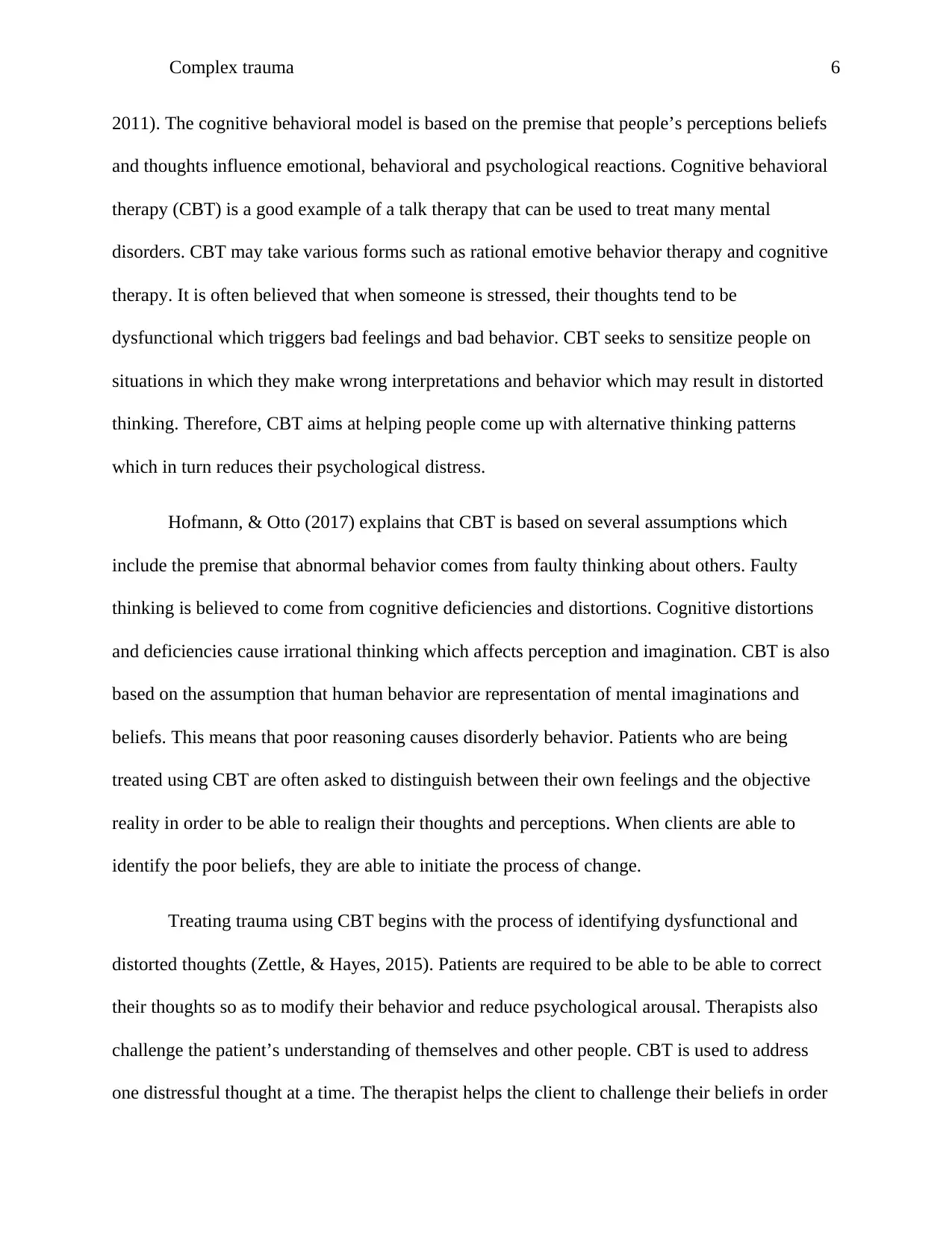
Complex trauma 6
2011). The cognitive behavioral model is based on the premise that people’s perceptions beliefs
and thoughts influence emotional, behavioral and psychological reactions. Cognitive behavioral
therapy (CBT) is a good example of a talk therapy that can be used to treat many mental
disorders. CBT may take various forms such as rational emotive behavior therapy and cognitive
therapy. It is often believed that when someone is stressed, their thoughts tend to be
dysfunctional which triggers bad feelings and bad behavior. CBT seeks to sensitize people on
situations in which they make wrong interpretations and behavior which may result in distorted
thinking. Therefore, CBT aims at helping people come up with alternative thinking patterns
which in turn reduces their psychological distress.
Hofmann, & Otto (2017) explains that CBT is based on several assumptions which
include the premise that abnormal behavior comes from faulty thinking about others. Faulty
thinking is believed to come from cognitive deficiencies and distortions. Cognitive distortions
and deficiencies cause irrational thinking which affects perception and imagination. CBT is also
based on the assumption that human behavior are representation of mental imaginations and
beliefs. This means that poor reasoning causes disorderly behavior. Patients who are being
treated using CBT are often asked to distinguish between their own feelings and the objective
reality in order to be able to realign their thoughts and perceptions. When clients are able to
identify the poor beliefs, they are able to initiate the process of change.
Treating trauma using CBT begins with the process of identifying dysfunctional and
distorted thoughts (Zettle, & Hayes, 2015). Patients are required to be able to be able to correct
their thoughts so as to modify their behavior and reduce psychological arousal. Therapists also
challenge the patient’s understanding of themselves and other people. CBT is used to address
one distressful thought at a time. The therapist helps the client to challenge their beliefs in order
2011). The cognitive behavioral model is based on the premise that people’s perceptions beliefs
and thoughts influence emotional, behavioral and psychological reactions. Cognitive behavioral
therapy (CBT) is a good example of a talk therapy that can be used to treat many mental
disorders. CBT may take various forms such as rational emotive behavior therapy and cognitive
therapy. It is often believed that when someone is stressed, their thoughts tend to be
dysfunctional which triggers bad feelings and bad behavior. CBT seeks to sensitize people on
situations in which they make wrong interpretations and behavior which may result in distorted
thinking. Therefore, CBT aims at helping people come up with alternative thinking patterns
which in turn reduces their psychological distress.
Hofmann, & Otto (2017) explains that CBT is based on several assumptions which
include the premise that abnormal behavior comes from faulty thinking about others. Faulty
thinking is believed to come from cognitive deficiencies and distortions. Cognitive distortions
and deficiencies cause irrational thinking which affects perception and imagination. CBT is also
based on the assumption that human behavior are representation of mental imaginations and
beliefs. This means that poor reasoning causes disorderly behavior. Patients who are being
treated using CBT are often asked to distinguish between their own feelings and the objective
reality in order to be able to realign their thoughts and perceptions. When clients are able to
identify the poor beliefs, they are able to initiate the process of change.
Treating trauma using CBT begins with the process of identifying dysfunctional and
distorted thoughts (Zettle, & Hayes, 2015). Patients are required to be able to be able to correct
their thoughts so as to modify their behavior and reduce psychological arousal. Therapists also
challenge the patient’s understanding of themselves and other people. CBT is used to address
one distressful thought at a time. The therapist helps the client to challenge their beliefs in order
⊘ This is a preview!⊘
Do you want full access?
Subscribe today to unlock all pages.

Trusted by 1+ million students worldwide
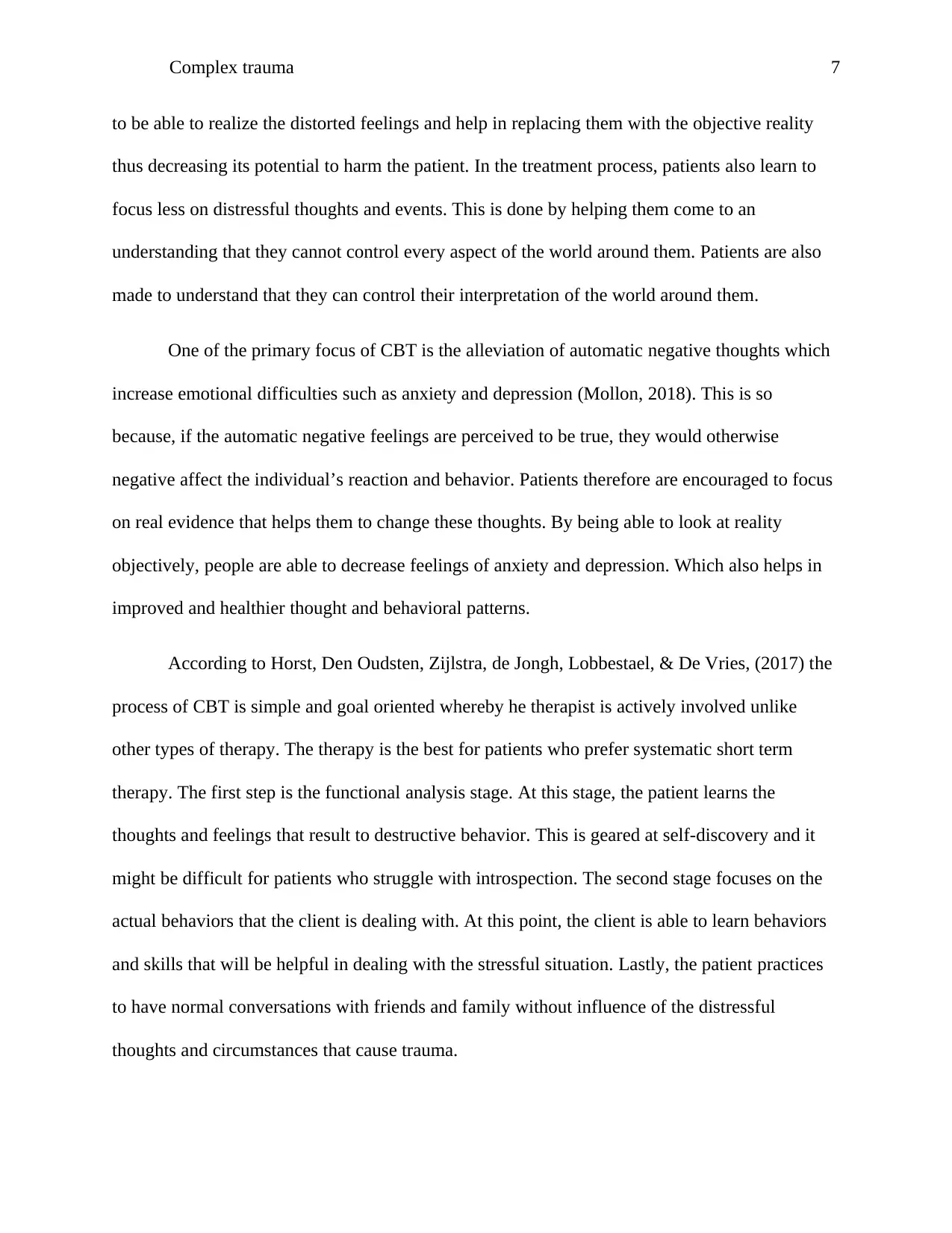
Complex trauma 7
to be able to realize the distorted feelings and help in replacing them with the objective reality
thus decreasing its potential to harm the patient. In the treatment process, patients also learn to
focus less on distressful thoughts and events. This is done by helping them come to an
understanding that they cannot control every aspect of the world around them. Patients are also
made to understand that they can control their interpretation of the world around them.
One of the primary focus of CBT is the alleviation of automatic negative thoughts which
increase emotional difficulties such as anxiety and depression (Mollon, 2018). This is so
because, if the automatic negative feelings are perceived to be true, they would otherwise
negative affect the individual’s reaction and behavior. Patients therefore are encouraged to focus
on real evidence that helps them to change these thoughts. By being able to look at reality
objectively, people are able to decrease feelings of anxiety and depression. Which also helps in
improved and healthier thought and behavioral patterns.
According to Horst, Den Oudsten, Zijlstra, de Jongh, Lobbestael, & De Vries, (2017) the
process of CBT is simple and goal oriented whereby he therapist is actively involved unlike
other types of therapy. The therapy is the best for patients who prefer systematic short term
therapy. The first step is the functional analysis stage. At this stage, the patient learns the
thoughts and feelings that result to destructive behavior. This is geared at self-discovery and it
might be difficult for patients who struggle with introspection. The second stage focuses on the
actual behaviors that the client is dealing with. At this point, the client is able to learn behaviors
and skills that will be helpful in dealing with the stressful situation. Lastly, the patient practices
to have normal conversations with friends and family without influence of the distressful
thoughts and circumstances that cause trauma.
to be able to realize the distorted feelings and help in replacing them with the objective reality
thus decreasing its potential to harm the patient. In the treatment process, patients also learn to
focus less on distressful thoughts and events. This is done by helping them come to an
understanding that they cannot control every aspect of the world around them. Patients are also
made to understand that they can control their interpretation of the world around them.
One of the primary focus of CBT is the alleviation of automatic negative thoughts which
increase emotional difficulties such as anxiety and depression (Mollon, 2018). This is so
because, if the automatic negative feelings are perceived to be true, they would otherwise
negative affect the individual’s reaction and behavior. Patients therefore are encouraged to focus
on real evidence that helps them to change these thoughts. By being able to look at reality
objectively, people are able to decrease feelings of anxiety and depression. Which also helps in
improved and healthier thought and behavioral patterns.
According to Horst, Den Oudsten, Zijlstra, de Jongh, Lobbestael, & De Vries, (2017) the
process of CBT is simple and goal oriented whereby he therapist is actively involved unlike
other types of therapy. The therapy is the best for patients who prefer systematic short term
therapy. The first step is the functional analysis stage. At this stage, the patient learns the
thoughts and feelings that result to destructive behavior. This is geared at self-discovery and it
might be difficult for patients who struggle with introspection. The second stage focuses on the
actual behaviors that the client is dealing with. At this point, the client is able to learn behaviors
and skills that will be helpful in dealing with the stressful situation. Lastly, the patient practices
to have normal conversations with friends and family without influence of the distressful
thoughts and circumstances that cause trauma.
Paraphrase This Document
Need a fresh take? Get an instant paraphrase of this document with our AI Paraphraser
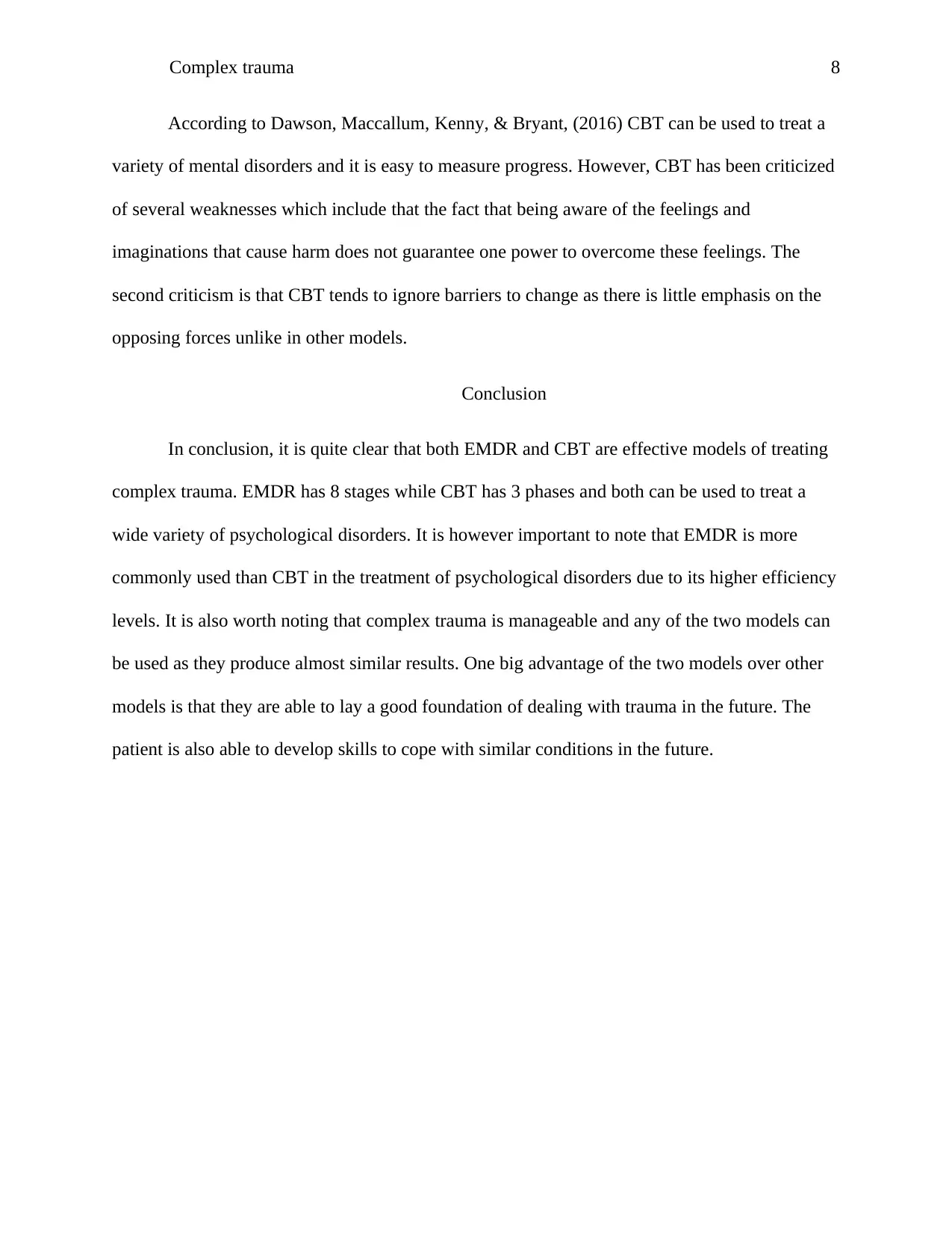
Complex trauma 8
According to Dawson, Maccallum, Kenny, & Bryant, (2016) CBT can be used to treat a
variety of mental disorders and it is easy to measure progress. However, CBT has been criticized
of several weaknesses which include that the fact that being aware of the feelings and
imaginations that cause harm does not guarantee one power to overcome these feelings. The
second criticism is that CBT tends to ignore barriers to change as there is little emphasis on the
opposing forces unlike in other models.
Conclusion
In conclusion, it is quite clear that both EMDR and CBT are effective models of treating
complex trauma. EMDR has 8 stages while CBT has 3 phases and both can be used to treat a
wide variety of psychological disorders. It is however important to note that EMDR is more
commonly used than CBT in the treatment of psychological disorders due to its higher efficiency
levels. It is also worth noting that complex trauma is manageable and any of the two models can
be used as they produce almost similar results. One big advantage of the two models over other
models is that they are able to lay a good foundation of dealing with trauma in the future. The
patient is also able to develop skills to cope with similar conditions in the future.
According to Dawson, Maccallum, Kenny, & Bryant, (2016) CBT can be used to treat a
variety of mental disorders and it is easy to measure progress. However, CBT has been criticized
of several weaknesses which include that the fact that being aware of the feelings and
imaginations that cause harm does not guarantee one power to overcome these feelings. The
second criticism is that CBT tends to ignore barriers to change as there is little emphasis on the
opposing forces unlike in other models.
Conclusion
In conclusion, it is quite clear that both EMDR and CBT are effective models of treating
complex trauma. EMDR has 8 stages while CBT has 3 phases and both can be used to treat a
wide variety of psychological disorders. It is however important to note that EMDR is more
commonly used than CBT in the treatment of psychological disorders due to its higher efficiency
levels. It is also worth noting that complex trauma is manageable and any of the two models can
be used as they produce almost similar results. One big advantage of the two models over other
models is that they are able to lay a good foundation of dealing with trauma in the future. The
patient is also able to develop skills to cope with similar conditions in the future.
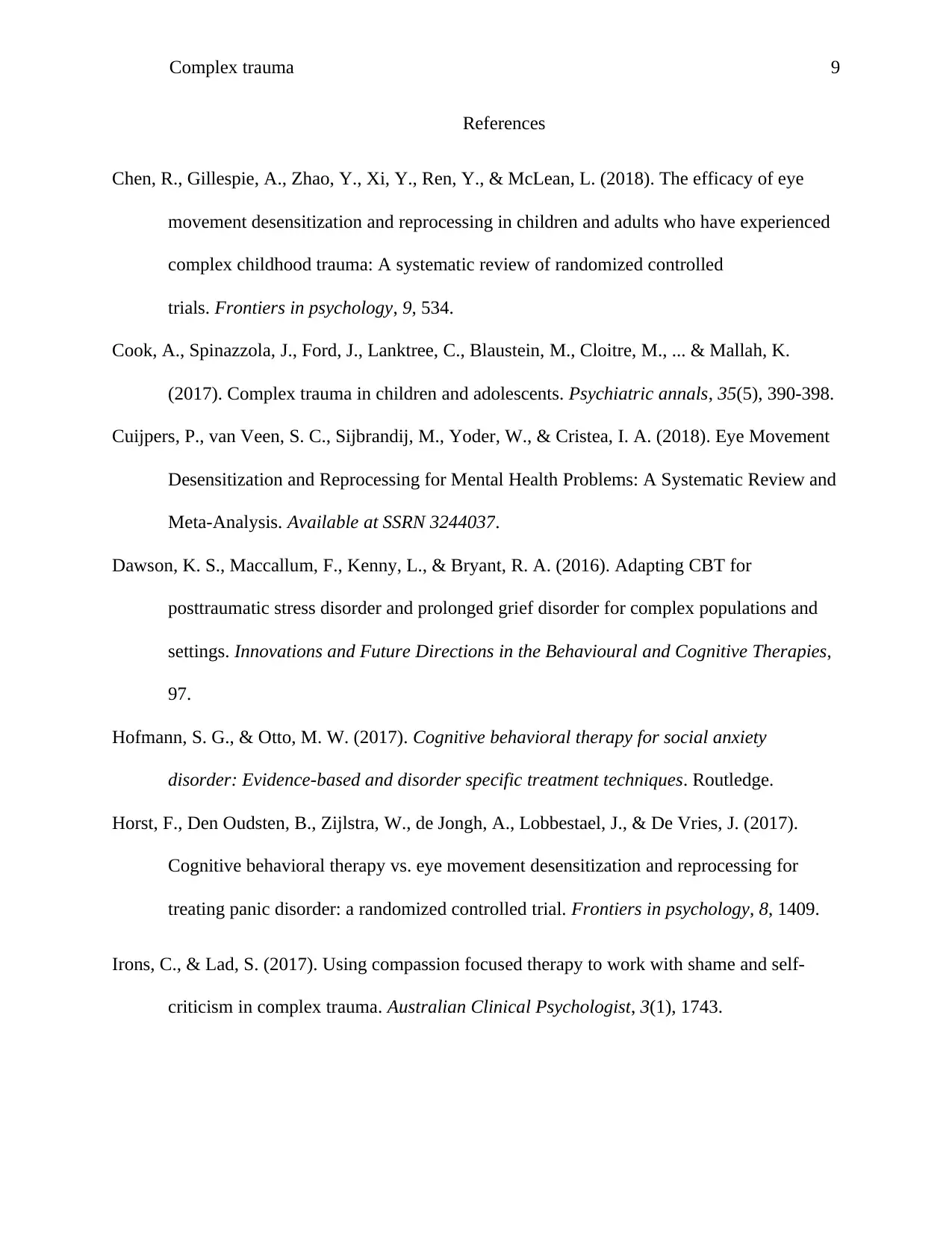
Complex trauma 9
References
Chen, R., Gillespie, A., Zhao, Y., Xi, Y., Ren, Y., & McLean, L. (2018). The efficacy of eye
movement desensitization and reprocessing in children and adults who have experienced
complex childhood trauma: A systematic review of randomized controlled
trials. Frontiers in psychology, 9, 534.
Cook, A., Spinazzola, J., Ford, J., Lanktree, C., Blaustein, M., Cloitre, M., ... & Mallah, K.
(2017). Complex trauma in children and adolescents. Psychiatric annals, 35(5), 390-398.
Cuijpers, P., van Veen, S. C., Sijbrandij, M., Yoder, W., & Cristea, I. A. (2018). Eye Movement
Desensitization and Reprocessing for Mental Health Problems: A Systematic Review and
Meta-Analysis. Available at SSRN 3244037.
Dawson, K. S., Maccallum, F., Kenny, L., & Bryant, R. A. (2016). Adapting CBT for
posttraumatic stress disorder and prolonged grief disorder for complex populations and
settings. Innovations and Future Directions in the Behavioural and Cognitive Therapies,
97.
Hofmann, S. G., & Otto, M. W. (2017). Cognitive behavioral therapy for social anxiety
disorder: Evidence-based and disorder specific treatment techniques. Routledge.
Horst, F., Den Oudsten, B., Zijlstra, W., de Jongh, A., Lobbestael, J., & De Vries, J. (2017).
Cognitive behavioral therapy vs. eye movement desensitization and reprocessing for
treating panic disorder: a randomized controlled trial. Frontiers in psychology, 8, 1409.
Irons, C., & Lad, S. (2017). Using compassion focused therapy to work with shame and self-
criticism in complex trauma. Australian Clinical Psychologist, 3(1), 1743.
References
Chen, R., Gillespie, A., Zhao, Y., Xi, Y., Ren, Y., & McLean, L. (2018). The efficacy of eye
movement desensitization and reprocessing in children and adults who have experienced
complex childhood trauma: A systematic review of randomized controlled
trials. Frontiers in psychology, 9, 534.
Cook, A., Spinazzola, J., Ford, J., Lanktree, C., Blaustein, M., Cloitre, M., ... & Mallah, K.
(2017). Complex trauma in children and adolescents. Psychiatric annals, 35(5), 390-398.
Cuijpers, P., van Veen, S. C., Sijbrandij, M., Yoder, W., & Cristea, I. A. (2018). Eye Movement
Desensitization and Reprocessing for Mental Health Problems: A Systematic Review and
Meta-Analysis. Available at SSRN 3244037.
Dawson, K. S., Maccallum, F., Kenny, L., & Bryant, R. A. (2016). Adapting CBT for
posttraumatic stress disorder and prolonged grief disorder for complex populations and
settings. Innovations and Future Directions in the Behavioural and Cognitive Therapies,
97.
Hofmann, S. G., & Otto, M. W. (2017). Cognitive behavioral therapy for social anxiety
disorder: Evidence-based and disorder specific treatment techniques. Routledge.
Horst, F., Den Oudsten, B., Zijlstra, W., de Jongh, A., Lobbestael, J., & De Vries, J. (2017).
Cognitive behavioral therapy vs. eye movement desensitization and reprocessing for
treating panic disorder: a randomized controlled trial. Frontiers in psychology, 8, 1409.
Irons, C., & Lad, S. (2017). Using compassion focused therapy to work with shame and self-
criticism in complex trauma. Australian Clinical Psychologist, 3(1), 1743.
⊘ This is a preview!⊘
Do you want full access?
Subscribe today to unlock all pages.

Trusted by 1+ million students worldwide
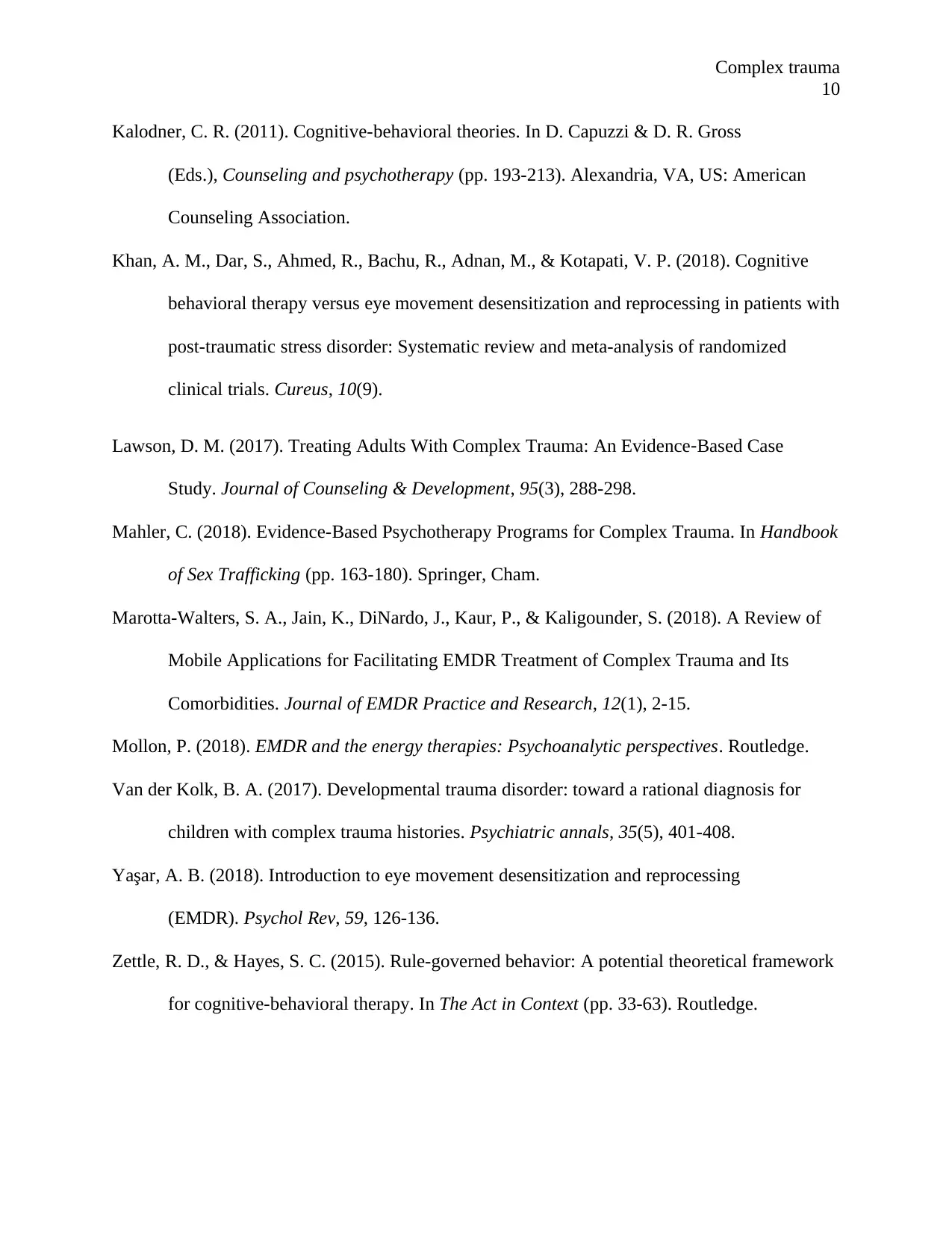
Complex trauma
10
Kalodner, C. R. (2011). Cognitive-behavioral theories. In D. Capuzzi & D. R. Gross
(Eds.), Counseling and psychotherapy (pp. 193-213). Alexandria, VA, US: American
Counseling Association.
Khan, A. M., Dar, S., Ahmed, R., Bachu, R., Adnan, M., & Kotapati, V. P. (2018). Cognitive
behavioral therapy versus eye movement desensitization and reprocessing in patients with
post-traumatic stress disorder: Systematic review and meta-analysis of randomized
clinical trials. Cureus, 10(9).
Lawson, D. M. (2017). Treating Adults With Complex Trauma: An Evidence‐Based Case
Study. Journal of Counseling & Development, 95(3), 288-298.
Mahler, C. (2018). Evidence-Based Psychotherapy Programs for Complex Trauma. In Handbook
of Sex Trafficking (pp. 163-180). Springer, Cham.
Marotta-Walters, S. A., Jain, K., DiNardo, J., Kaur, P., & Kaligounder, S. (2018). A Review of
Mobile Applications for Facilitating EMDR Treatment of Complex Trauma and Its
Comorbidities. Journal of EMDR Practice and Research, 12(1), 2-15.
Mollon, P. (2018). EMDR and the energy therapies: Psychoanalytic perspectives. Routledge.
Van der Kolk, B. A. (2017). Developmental trauma disorder: toward a rational diagnosis for
children with complex trauma histories. Psychiatric annals, 35(5), 401-408.
Yaşar, A. B. (2018). Introduction to eye movement desensitization and reprocessing
(EMDR). Psychol Rev, 59, 126-136.
Zettle, R. D., & Hayes, S. C. (2015). Rule-governed behavior: A potential theoretical framework
for cognitive-behavioral therapy. In The Act in Context (pp. 33-63). Routledge.
10
Kalodner, C. R. (2011). Cognitive-behavioral theories. In D. Capuzzi & D. R. Gross
(Eds.), Counseling and psychotherapy (pp. 193-213). Alexandria, VA, US: American
Counseling Association.
Khan, A. M., Dar, S., Ahmed, R., Bachu, R., Adnan, M., & Kotapati, V. P. (2018). Cognitive
behavioral therapy versus eye movement desensitization and reprocessing in patients with
post-traumatic stress disorder: Systematic review and meta-analysis of randomized
clinical trials. Cureus, 10(9).
Lawson, D. M. (2017). Treating Adults With Complex Trauma: An Evidence‐Based Case
Study. Journal of Counseling & Development, 95(3), 288-298.
Mahler, C. (2018). Evidence-Based Psychotherapy Programs for Complex Trauma. In Handbook
of Sex Trafficking (pp. 163-180). Springer, Cham.
Marotta-Walters, S. A., Jain, K., DiNardo, J., Kaur, P., & Kaligounder, S. (2018). A Review of
Mobile Applications for Facilitating EMDR Treatment of Complex Trauma and Its
Comorbidities. Journal of EMDR Practice and Research, 12(1), 2-15.
Mollon, P. (2018). EMDR and the energy therapies: Psychoanalytic perspectives. Routledge.
Van der Kolk, B. A. (2017). Developmental trauma disorder: toward a rational diagnosis for
children with complex trauma histories. Psychiatric annals, 35(5), 401-408.
Yaşar, A. B. (2018). Introduction to eye movement desensitization and reprocessing
(EMDR). Psychol Rev, 59, 126-136.
Zettle, R. D., & Hayes, S. C. (2015). Rule-governed behavior: A potential theoretical framework
for cognitive-behavioral therapy. In The Act in Context (pp. 33-63). Routledge.
1 out of 10
Related Documents
Your All-in-One AI-Powered Toolkit for Academic Success.
+13062052269
info@desklib.com
Available 24*7 on WhatsApp / Email
![[object Object]](/_next/static/media/star-bottom.7253800d.svg)
Unlock your academic potential
Copyright © 2020–2025 A2Z Services. All Rights Reserved. Developed and managed by ZUCOL.





